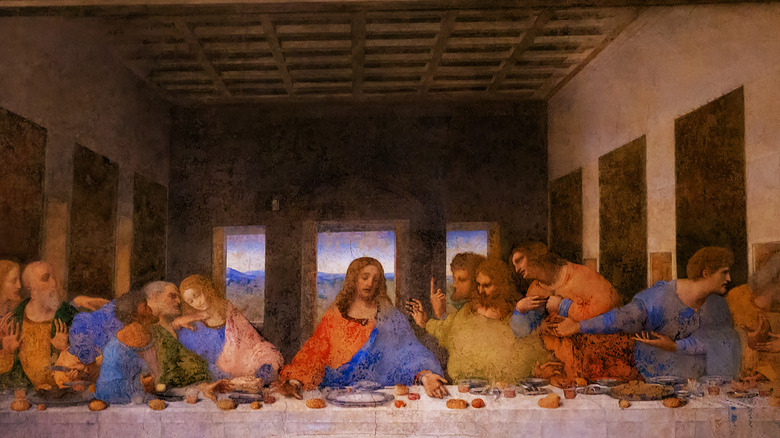What Was On The Table At The Last Supper?
"Take and eat; this is my body," Jesus said at his last meal before the crucifixion (Matthew 26:26). The Gospel of Matthew states that Jesus passed the unleavened bread and shared it with his disciples before predicting that one of them would betray him soon after. But what kind of bread was broken, wine drunk? What we knew of the actual contents of the Last Supper was limited to some nondescript Bible verses and Leonardo Da Vinci's depiction of the scene. But with the help of some archaeologists and historians, we may have a better, more accurate picture of the food on the table.
Of course, Da Vinci's famous mural is vibrant, the disciples are clothed in jewel-toned garments, and their leader Jesus sits at the center with plates of round bread loaves. While it is an amazing sight, Leonardo's painting is purely imaginative; after all, he came 1.5 millennia after Christ lived. The puffed-up dinner rolls of Da Vinci's mural surely cannot be the unleavened bread mentioned in the Bible. So what food was actually on the table at the Last Supper? This much is already known: early Christian artists added fish to the table, which was symbolic of the Eucharist (via Britannica).
Passover food
Italian archaeologist, Generoso Urciuoli, looked to Roman laws and Jewish tradition to assemble the table spread of the Last Supper, as shown in Live Science. The Bible verses Matthew 26:17-30 indicate that this was a celebration of the Passover, a major Jewish holiday celebrating their exodus out of Egypt. Of course, the passage states that there was unleavened bread and wine, which have become the inspiration for the Christian practice of communion. But what else was in this Last Supper?
Urciuoli, combining his knowledge of traditional Passover foods with Roman culinary practices, speculates that there was lamb on the table, which was a traditional meat used in Passover celebrations. The unleavened bread was most likely matzah, a traditional flatbread that is broken during Passover Seder, per Chabad. Urciuoli also believes that there was some tzir, which is a type of garum or Roman fish sauce used in the first form of deviled eggs. The table probably had cholent (a bean stew), olives with hyssop, charoset paste (a paste of ground fruits and nuts), and maror (bitter herbs). But how does this compare to Da Vinci's version of the Last Supper? HuffPost cites John Varriano, a late art professor at Mount Holyoke College, who looked closely to find bread rolls, red wine, and eels garnished with citrus. Varriano believed that Da Vinci's mural featured the food of his own time, the 1490s, rather than what Jesus and his disciples would've had during the Last Supper.

